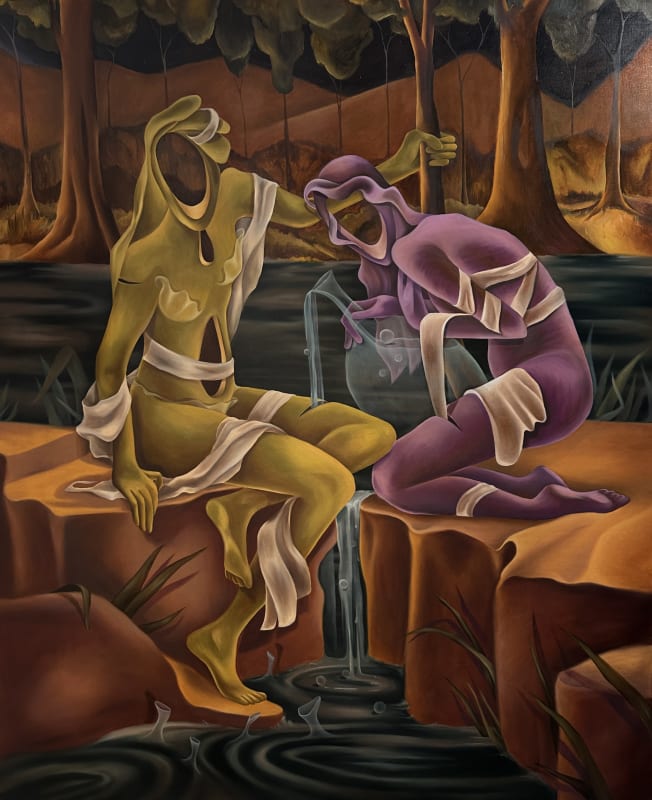Private View: Wednesday, 14th February 2024, 7 - 9pm
Berlin
A collection of fuzzy, sagging, translucent, ghoulish and rock-like creatures gather against moody pink skies, in the depths of the forest, on the banks of a lake. These eccentric, friendly and sometimes fragmented characters are, to the Ukrainian artist Rita Maikova, a kind of family. They have followed her through different stages of her life; mutating in form and colour, coming and going, seemingly, at their own will, while also providing a sense of stability and solace. Featuring all new work, Find Me in the Garden, Maikova’s solo exhibition at Kristin Hjellegjerde Gallery, Berlin documents a period of personal transition during which the artist moved countries and also became pregnant with her first child. However, rather than capturing external upheavals, these paintings offer a space of calm and reflection. They are not so much a retreat from the real-world as a journey deep into the self.
For Maikova art-making is a form of healing and freedom – it allows her to access her unconscious mind, to dream without the boundaries of time and space. We see this in the fluidity of forms that populate her compositions, through the ways in which her creatures appear, often simultaneously, as rock-like formations, undulating bodies and huge, anthropomorphic beasts. The landscapes they populate are typically barren and desert-like, inspired by Maikova’s upbringing in the vast, open steppe of southern Ukraine, but in this latest series, we also encounter them in lush, green forest-like settings that recall the language of myths and fairy-tales. This is perhaps most obvious in Save Narcissus, a reinterpretation of a painting by Jan Cossiers which depicts Narcissus who, according to Greek myth, fell in love with his own reflection in a pool of water and died alone. Maikova’s Narcissus is similarly entranced but by the water rather than their own reflection. For Maikova, water is a magical, healing source. Out of the surface of the pool, there are little translucent forms emerging, one of which is also within the mouth of Narcissus and seen in other paintings travelling across the land. ‘They are water spirits,’ Maikova explains, ‘who hold ancient knowledge and powers.’
In another work, a homage to John William Waterhouse’s Nymphs Finding the Head of Orpheus (1900), we encounter two fragmented female figures, or rather two versions of the same figure, seated on the edge of a waterfall seemingly about to wash or perform some kind of cleansing or healing ritual. They are, like many of the other characters, draped in silky ribbons that serve the dual purpose of both bandages – wrapped over or through the fissures in the characters’ bodies – and clothing or costume. Indeed, there is a theatrical quality to several of the works that taps into ideas around childhood and play. Two paintings depict sandy coloured creatures that appear like camels with their odd, humped-back silhouettes, but are, in fact, representations of the dragons that Maikova and her friend dreamt up as children. ‘We believed the dragons would come and take us into a magical world,’ she says. This is the first time they have appeared in her paintings, each acting as both transportation and residence for a number of her other small creatures. One even appears beneath a glossy, purple curtain as if about to perform some kind of performance or trick. The exhibition’s title references this idea of playfulness and also, perhaps, a longing to return to the simplicity and freedom of childhood.
It makes sense that Maikova would experience nostalgia for her own youth just as she is about to become a mother, but the works also express a sense of connection or synergy between the past, the present and the future. In the desert paintings, especially, her characters are intrinsically interconnected, their forms or ‘limbs’ overlapping or weaving through one another to create miniature, self-sustaining ecosystems, at the heart of which there is often a tiny, luminous egg. This is the only direct reference in the works to pregnancy and motherhood, but it is, nevertheless, an important symbol of the way in which Maikova is attempting to find a sense of unity between who she was and is, and who she will become.
As she says: ‘We continue to live in a very scary and unstable time, and while I’m not ignoring what’s happening, I believe it is important to also step back, to listen to our instincts and the wisdom of nature so that we can heal ourselves and help to heal others.’


